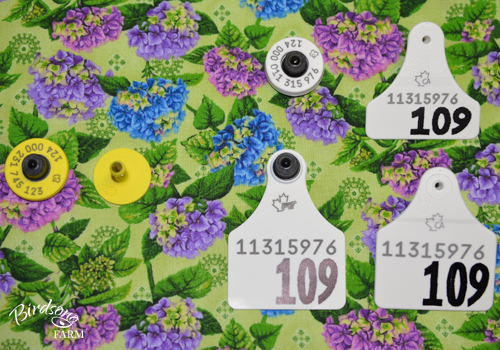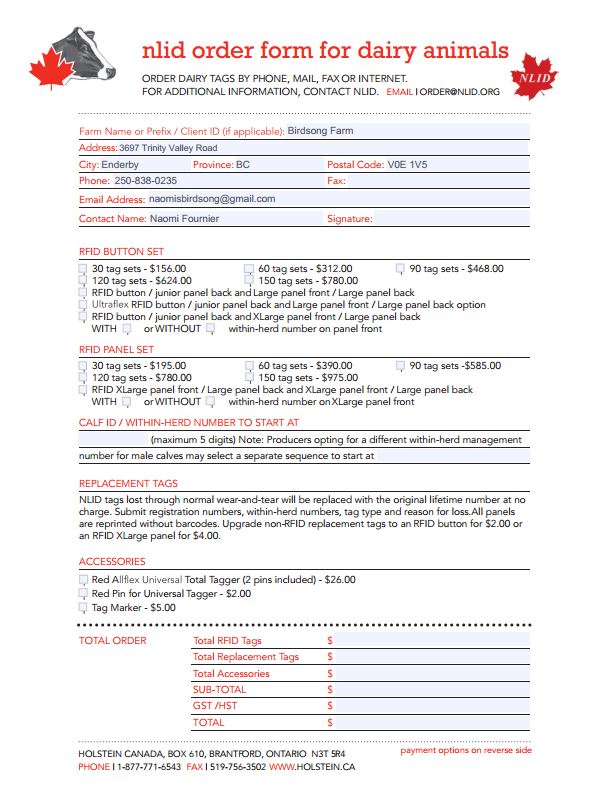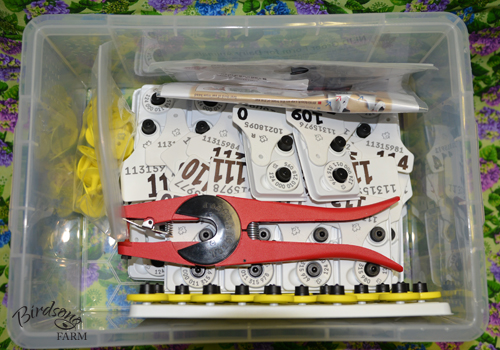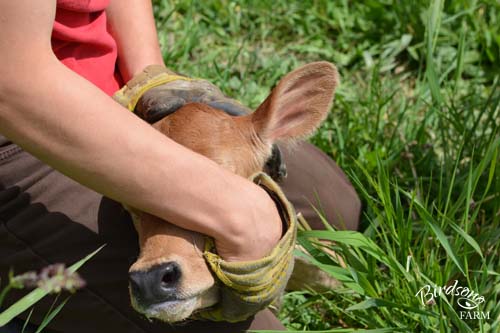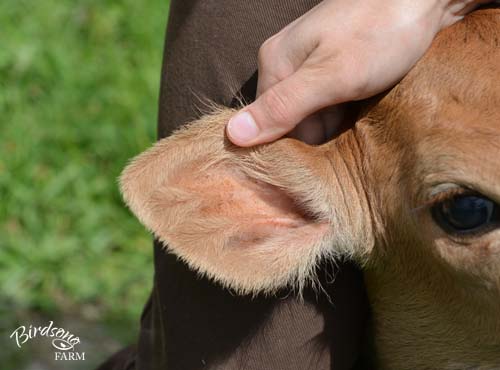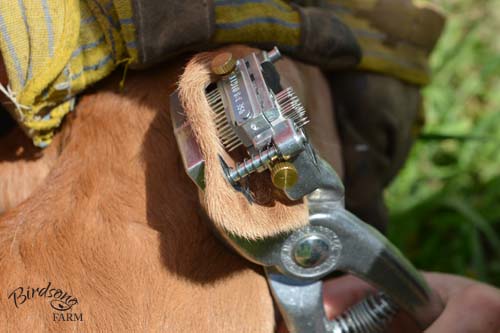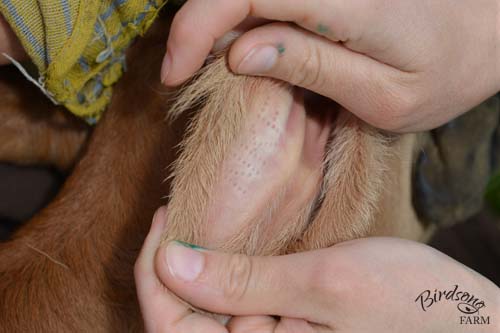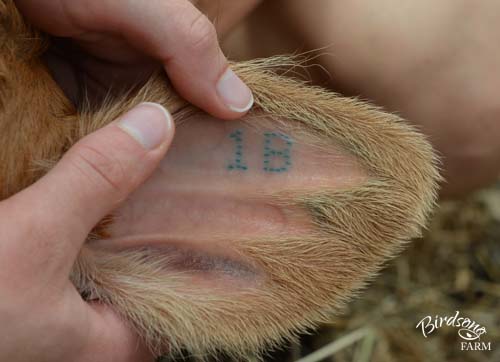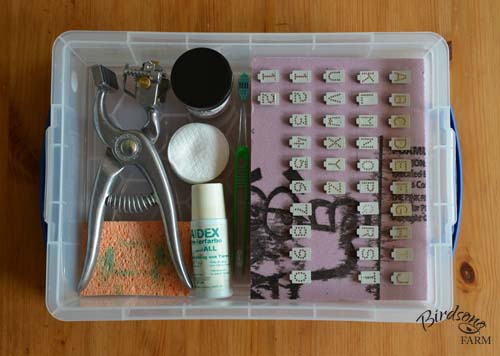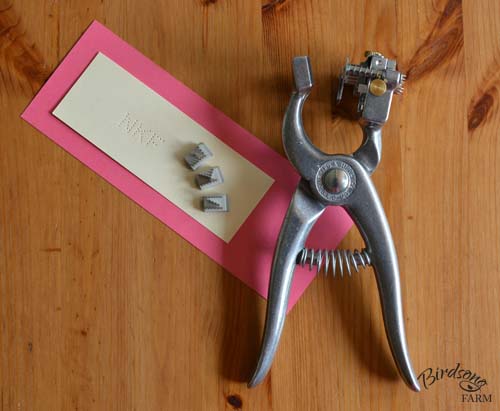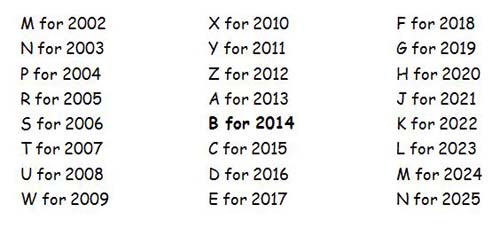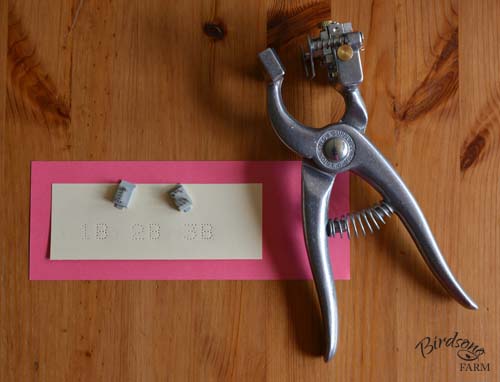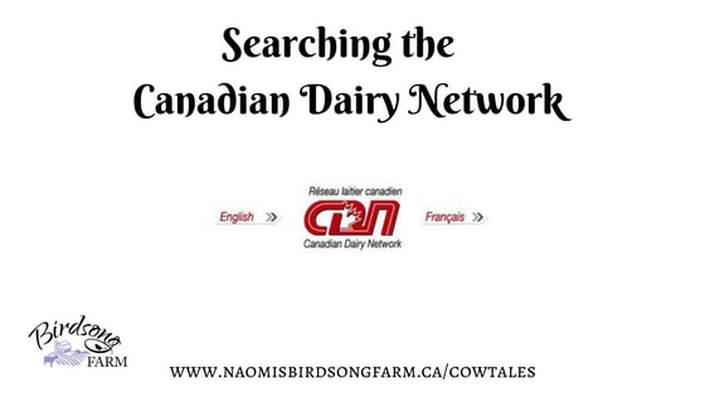|
Today's post about tagging your Jersey calf is the third post in a series that I am writing about tattooing, tagging, and registering your calf with Jersey Canada.
You are required to tattoo or tag your calf before registering her with Jersey Canada. I tattoo and tag, but both are not required and many dairy farmers choose to tag but not tattoo. I choose to tattoo because tags can get lost, plus it's a lot harder to tamper with a tattoo than with a tag. I tag my calves because in Canada you are required to tag all cattle before they leave the farm where they were born, which is known as the farm of origin. I tag my calves about two weeks after tattooing, when they are about a month old. There are two types of tags for cattle: the yellow CCIA (Canadian Cattle Identification Agency) tags which are reserved for tagging beef cattle, and the white NLID (National Livestock Identification for Dairy) tags which are reserved for tagging dairy cattle. The breeds that you tag with the white NLID tags are the Ayshire, Brown Swiss, Canadienne, Guernsey, Holstein, Jersey, Milking Shorthorn, and Norwegian Red breeds; dairy calves that are being raised for beef can be tagged with the white NLID tags, or the yellow CCIA tags.
Purchase your tagging kit
Before you tag, you will want to order your tagging pliers and a package of NLID tags. Holstein Canada administers the NLID program, and you can order everything you require by clicking here. Start out by filling out the order form with your farm name or prefix (my farm name is Birdsong Farm; my prefix, which I've registered with Jersey Canada, is Birdsong), or with your client identification if you've created an account with Holstein Canada.
Tags First, choose how many tag sets you wish to buy: 30, 60, 90, 120, or 150 tag sets. I purchased a 30 tag set in 2011, and I've tagged six calves in the past three years. I'm guessing that the remaining 24 tags will keeping me going for another twelve years!
Next, choose which of the four styles of tags you wish to buy. There are three RFID button styles that cost $5.20 per set, and one RFID panel style that costs $6.50 per set. RFID button/junior panel back and large panel front/large panel back ($5.20/set) This is the style of tag that I tag my calves with, as they are the ideal size for Jerseys. The RFID button is 1-1/4 inches in diameter, while the junior back panel is 2-1/4 inches in length and 2 inches in width. The large front panel is 3 inches in length and 2 inches in width, while the large back panel is 2-3/4 inches in length and 2 inches in width. Ultraflex RFID button/junior panel back and large panel front/large panel back ($5.20/set) These tags are like the first option, but the back panels of both tags are a rounded triangular shape. They are made with a pliable plastic, and the stem of the male tag is thicker and shorter so that the tags are less likely to catch on feeders and twine. RFID button/junior panel back and extra large panel front/large panel back ($5.20/set) These tags are like the first option as well, but the large front panel is replaced with an extra large panel. These extra large panels are huge--4 inches in length and 3 inches in width--and Holstein Canada reports that Jersey breeders find that the extra large tags are so heavy that they rip out of their calves ears. RFID extra large panel front/large panel back and extra large panel front/large panel back ($6.50/set) The extra large front panels on both tags are 4 inches in length and 3 inches in width, and the large back panels are 3 inches in length and 3 inches in width. The RFID button is on one of the extra large panels. Again, this style is not recommended for Jerseys. Finally, would you like your new tags with or without herd numbers? There is no extra charge for herd numbers, so I purchased my tags with numbers and I'm really glad I did. I know my cows by name, but when my brother looks at the cows it's easier to ask him "What do you think about 108?" than "What do you think about Buttercup?" and try to describe what she looks like. If you want tags with herd numbers, you get to choose where your numbers start and are limited to five digits. I know many farmers who start with the number 1, but I wanted three digits on my tags. I started with the number 100 for my first cow, Blossom, and began counting from there for the calves born on the farm. So Daisy is 101, Aster is 102, Princess Sonja is 103, Shirley Rose is 104, Diana is 105, Grace is 106, Alexandra is 107, and Buttercup is 108. The next heifer calf born on the farm--you guessed it--will be given tags with the number 109. If you are tagging a calf every year or two, 30 tags will last you a lifetime. Skip buying the tags and find a dairy farmer or a farm that raises dairy cattle (like Birdsong Farm) who is willing to sell you tag sets as needed. Or you can tattoo your calf and register her first, and then order replacement tags for her.
Tag marker If you want tags without herd numbers, you can buy the tag marker for $5.00 and write the calf's name (and even her birthdate) on her tag instead. (If your tags are numbered with one or two digits, there may still be space for writing a name.)
Tag pliers You will need to buy a red AllFlex Universal Total Tagger for $26.00. You will require a green pin for the Ultraflex tags, and a red pin for all the other tag styles. Soft cloth or paper towel You will want to clean your calf's ears before you start tagging. Paper towels are fine, but I like the microfiber dairy towels wet with plain water because they are so soft and remove 99% of bacteria, plus I can rewash them for the next calf. Antiseptic/disinfectant You will want to clean your calf's ears with an antiseptic before you tag, and will want to clean the tags with a disinfectant as well. Cotton balls or pads I pour a little antiseptic/disinfectant on cotton balls or pads to clean my calf's ears and the tags and kill any bacteria. If you wish, you can dip the tags in a jar of disinfectant instead. Storage box You can buy a fancy storage box for your tagging kit, but I purchased a clear 9 litre Really Useful Box from Staples instead. I store my tagging pliers and all my NLID and CCIA tags in the box. Best of all, I can stack my tattoo box on top of it and keep my tattooing and tagging kits in one place. 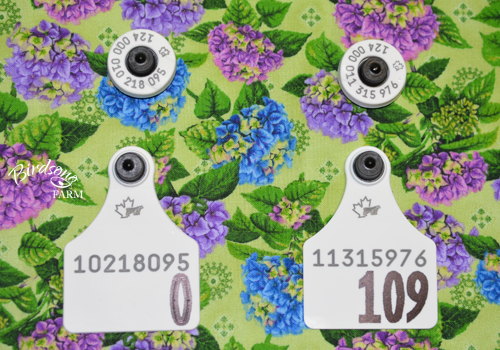
These tags are the RFID button and the large front panel for the RFID/junior panel back and large panel front/large panel back tags. The tag on the left with one digit is a replacement tag for Gaymar Jester Fancier, and the tag on the right with three digits is waiting for the next heifer calf to be born.
This is the first post in a two-part series about how to tattoo your Jersey calf; please click here to read the second post.
0 Comments
This is the second post in a two-part series about tattooing your Jersey calf; please click here to read the first post.
I've found that tattooing takes at least two people (one to restrain the calf and one to tattoo), so I always ask one of my brothers or sisters to give me a hand. A younger sibling often tags along as well and hands me my pliers, ink, et cetera as I ask for them. If no brothers are handy when you tattoo, I recommend that you ask a friend or neighbour to assist you. Prepare your calf The first step is restraining your calf. I'm always amazed at how strong a two-week-old heifer is, so strong brothers are very handy.
After your calf is restrained, you will want to clean the inside of her ears with a soft cloth or paper towel wet with plain water, and then with a cotton ball or pad wet with the antiseptic of your choice. Calf ears are often quite waxy (that's a good thing—waxy ears are a sign of high butterfat milk in her future), so it might take a bit of work to get them squeaky clean.
Tattoo! Your herd tattoo letters go in your calf's right ear, and the animal number and year letter go in your calf's left ear. Remember that the calf's ears are reversed when you are facing her (her right ear is on your left and vice versa). Traditionally, the tattoos were placed between the two ribs in the calf's ear, but now that Canadian farmers are required to tag dairy cattle before they leave their farm of birth many farmers place the tattoos above the top rib and reserve the space between the two ribs for the tags. I place all my tattoos above the top rib; this way the tattoo isn't in the way when I tag the calf at a later date, and if the tags ever rip out the tattoo is not damaged.
Most farmers will apply the ink to the ear before tattooing; I always tattoo first and then double check the letters and readability of the tattoo before I apply the ink. This way if I make a mistake while I'm tattooing, it's easy to fix—I skip the ink and retattoo in a couple weeks.
When your calf's ears are dry, double check your tattoo digits and position your tattoo pliers, remembering to watch out for the big blood veins (if you hit one of the big veins the blood can damage your tattoo; the small veins are fine). When the tattoo pliers are in position, I gently squeeze them so that the positive ear release is touching the ear, but the tattoo needles are not. Ask your assistant to keep the calf from squirming while you squeeze the pliers, and then count to three...one...two...three...and squeeze on three. Squeeze the pliers firmly (you'll feel a little "crunch") for a deep, clear tattoo. The positive ear release on the Stone tattoo pliers releases the ear from the tattoo needles and keeps the tattoo crisp and clear with no scratches.
Check your handiwork, and if everything looks good apply ink to the tattoo. I rub the ink in with my thumb and a soft toothbrush that I've reserved for tattooing and keep with my tattoo kit. You may want to apply ink two or three times to get good coverage—you want to make a tattoo that lasts the lifetime of the cow. Leave the extra ink on; it will dry out and flake off.
When you are finished, repeat on the other ear, remembering to change your tattoo digits. I always tattoo the right ear with my herd letters first, and then tattoo the left ear with the animal number and year letter.
Congratulations! You've finished tattooing your first calf! You'll find that tattooing gets easier every time—it took me two and a half calves (five ears) to stop cringing with the "crunch".
There are two new baby calves on the farm--Birdsong Princess Alexandra (born May 30, 2014) and Birdsong Golden Buttercup (born July 13, 2014)—and over the next few months I am going to write a series of blog posts about tattooing, tagging, and registering a calf with Jersey Canada, with Alexandra and Buttercup as my models.
When registering a calf with Jersey Canada, you are required to tattoo or tag her first. I tattoo and tag, but both are not required and many dairy farmers choose to tag but not tattoo. I choose to tattoo because tags can get lost, plus it's a lot harder to tamper with a tattoo than with a tag! I tattoo my calves when they are between one and three weeks of age. I don't like to tattoo earlier than one week because I want to give my calves a chance to "get on their feet" first, or after three weeks because the calves are harder to restrain. Register your herd tattoo letters Before you start doing any tattooing, you are required to register your herd tattoo letters with Jersey Canada for $5 plus tax. Your herd tattoo letters are three or four digits that are tattooed in the right ear of every calf that you register. This tattoo will identify you as the owner of the calf when she was born. For example, if you buy a bred cow and register her calf, you will tattoo the calf with your herd tattoo letters, not the herd tattoo letters of the previous owner. You can choose letters or letters and numbers for your herd tattoo, and often farmers will choose their initials or the initials of their farm name. For example, I registered my initials, NKF, as my herd tattoo while my friend Melanie Guttner from Butterkup Farms in Pink Mountain, BC registered her farm initials, BKF, as her herd tattoo. But you aren't limited to initials—I found Jersey farmers with COW and MOO registered as their herd tattoo letters! Purchase your tattoo kit The two brands of livestock tattoo equipment that I am aware of are Ketchum and Stone. I ordered my tattoo kit from Valley Vet Supply in Marysville, Kansas. They've got a great mail-order catalogue and good prices. You will want to buy the following items for your tattoo kit: Tattoo pliers When I researched my options for tattoo pliers, I really liked the look as well as the price of the Stone brand, and the positive ear release was a big plus for me. Stone sells 3/16 inch, 5/16 inch, and 3/8 inch tattoo kits (that's the size of the tattoo digits); the 3/8 inch kit is your best choice for tattooing calves. I wanted to keep my herd tattoo letters in my pliers all the time, so ordered the 3/8 inch revolving head tattoo kit. I'm glad I did, because it makes tattooing a breeze—no switching digits between ears, no searching for lost digits in the grass or hay, and no tattooing errors because I reversed the digits by mistake. Complete alphabet set (A-Z) You can buy your tattoo letters one by one, but it's a lot cheaper (15% cheaper before adding postage costs) to buy a complete set. Remember to match your tattoo digit size to your plier size, or they will not fit. For example, if you buy 3/8 inch pliers, you'll want to buy 3/8 inch digits. Complete number set (0-9) You can buy your tattoo numbers one by one as well, but again, it's a lot cheaper to buy a complete set. My tattoo pliers already came with a complete number set, like all of the Stone tattoo kits from Valley Vet Supply. Extra tattoo digits If you want to keep your herd tattoo in your pliers all the time, you might want to buy an extra set of the letters (or letters and numbers) that are registered as your herd tattoo letters. I ordered an extra N, K, and F for my herd tattoo letters. If you think you'll be tattooing a lot of calves (or goat kids ) you may want to buy a couple extra numbers as well. I ordered an extra 1 and 2, and with these two extra digits I can tattoo as high as 32! (So far I've never tattooed higher than 2 with my Jerseys and 4 with my Nubians.) Tattoo ink You can buy tattoo ink in black, green, or white, and as a liquid, paste, or roll-on. Green is your best choice because it is visible in both dark and light ears. My tattoo kit came with black liquid tattoo ink like all of the Stone tattoo kits from Valley Vet Supply, but I ordered green roll-on ink as well and really like it because there are no messy spills and the ink will not dry out between calves. Soft cloth or paper towel You will want to clean your calf's ears before you start tattooing. Paper towels are fine, but I like the microfiber dairy towels wet with plain water because they are so soft and remove 99% of bacteria, plus I can rewash them for the next calf. Antiseptic/disinfectant You will want to clean your calf's ears with an antiseptic before you tattoo, and will want to clean your tattoo digits with a disinfectant both before and after tattooing. Cotton balls or pads I pour a little antispetic/disinfectant on cotton balls or pads to clean my calf's ears and the tattoo digits and kill any bacteria. Soft toothbrush You might want to buy a soft toothbrush to rub the ink in the tattoo you've made. Sponge A sponge works really well for cleaning your tattoo digits when you're finished. Storage box You can buy fancy storage boxes for your tattoo kit, but I purchased a clear 4 liter Really Useful Box from Staples instead and my brothers cut me a piece of 1 inch rigid foam insulation to store my tattoo digits in. It was a lot cheaper and I'm really happy with it.
Prepare your tattoo equipment
Find your herd tattoo letters and insert them in your tattoo pliers. Since you tattoo your herd letters in your calf's right ear, I highly recommend that you insert the digits starting from the left side for a crisp, clear tattoo; if you insert the digits starting from the right side the tattoo will be closer to the outside of the ear and not as nice. Remember to insert the digits backward as well; I inserted my herd tattoo letters, NKF, as FKN. When you are finished, check for mistakes by tattooing a piece of heavy paper first. I never take my herd tattoo letters out of my pliers, but I still double check them every time I tattoo 'cause it's a lot easier to fix a mistake before I start doing any tattooing!
Next, choose your animal number and the year letter and insert them in the other side of your tattoo pliers. Since you tattoo your animal number and the year letter in your calf's left ear, I highly recommend that you insert the digits starting from the right side for a crisp, clear tattoo.
The year letter is assigned by Jersey Canada, and the letter for 2014 is 'B'. You will tattoo the first calf that you register in 2014 with 1B, the second calf with 2B, and the third calf with 3B. For example, Alexandra is tattooed with NKF in her right ear and 1B in her left ear, and Buttercup is tattooed with NKF in her right ear and 2B in her left ear. The year letter for 2015 is 'C', so next year you will tattoo your calves as 1C, 2C, 3C... The letters I, O, Q, and V are not designated as year letters, so the rest of the letters in the alphabet are repeated every 22 years. For example, you will find animals tattooed with the letter 'B' in 1992, 2014, and again in 2036.
Remember that you will want to insert the digits backward again (1B will be inserted as B1), and when you are finished check for mistakes by tattooing a piece of heavy paper first.
After you've checked (and maybe double checked ) your herd tattoo letters and the animal number/year letter, it's time to clean the tattoo digits with your disinfectant of choice. Now you're ready to tattoo your first calf!
This is the first post in a two-part series about how to tattoo your Jersey calf; please click here to read the second post. If you raise registered dairy cattle or want to research your new family cow, you should check out the Canadian Dairy Network. This amazing website is where you can search for the registrations and records of eight breeds of dairy cattle: Ayrshire, Brown Swiss, Canadienne, Guernsey, Holstein, Jersey, Milking Shorthorn, and Norwegian Red. In this blog post, I'm going to guide you as you learn about searching for records, with my registered Jerseys as the models.
|
Categories
All
Archives
January 2020
|
